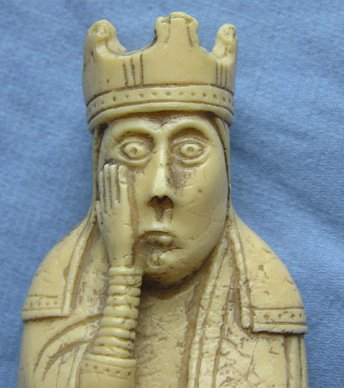However, there are kids with different abilities and patience, which results in different lengths of games. As a result, this tournament was threatening to stretch out for the remainder of the year; something that just wouldn’t do. Our spring break is tied to Easter, so I decided that was a good break point at which to end the tournament. Unfortunately, I had kids who had played as few as five games, and some who had played as many as ten. How should I rank them?
I used a traditional scoring method for the games: 1 point for a win, 0 points for a loss, and a ½ point to each player for a draw or stalemate. From that, I could compute the average number of points per game for each child, effectively normalizing the data to one game. Now I had points/game for everyone, ranging from 0.80 pts/g to 0.0 pts/g. Ranking came pretty easily, as the first three slots were unique numbers.
 | ||
| Lewis Chess Queen (Finlay McWalter) |
What did I learn from all of this? I learned three things, two of which are significant:
- Do this at the beginning of the year to provide motivation for everyone. This will also show where the children fall out in terms of “chess education”.
- Chess clocks would be a great help. A 10 minute per game limit would allow for two games per player per week (we meet for an hour) with sufficient time for clean-up.
- Less importantly, it is amazing how many stalemates show up in games at this level! The kids tend to promote pieces to Queens, and then are shy about moving right up against the King and putting the King in check! The result of two Queens and a Rook attacking timidly is very often a stalemate, just because the attacked King has nowhere to go!
It’s Your Move!

No comments:
Post a Comment
Go ahead and trash talk -- I can handle it!